ikfoundation.org
The IK Foundation
Promoting Natural & Cultural History
Since 1988


JACKETS, SWEATERS AND GANSEYS
19th Century Fishermen’s Garments along the North Yorkshire Coast
The dyeing of yarn and cloth was revolutionised after 1856, when aniline dyes were discovered, using a chemical-based process that made manufacturing entirely new colours possible. The most popular new shades were the strong ones, which had previously been achieved only by using expensive natural dyes or, in some cases, even impossible to obtain – these included purple or mauve, rose, turquoise and ultramarine. Dark blue or ultramarine became a particularly favoured colour for yarn knitted into warm woollen ganseys in many coastal communities in England from the 1870s and onwards. This essay will look at these traditions by comparing earlier artworks which illustrated men in small boats off the Whitby coast and in the harbour alike, all dressed in various woollen cloth jackets and stripy knitted sweaters of predominantly white, yellow and red colours. In contrast to pictures taken by the famous photographer Frank Meadow Sutcliffe of Whitby fishermen from the 1880s to 1900s, everyone wore knitted blue ganseys.
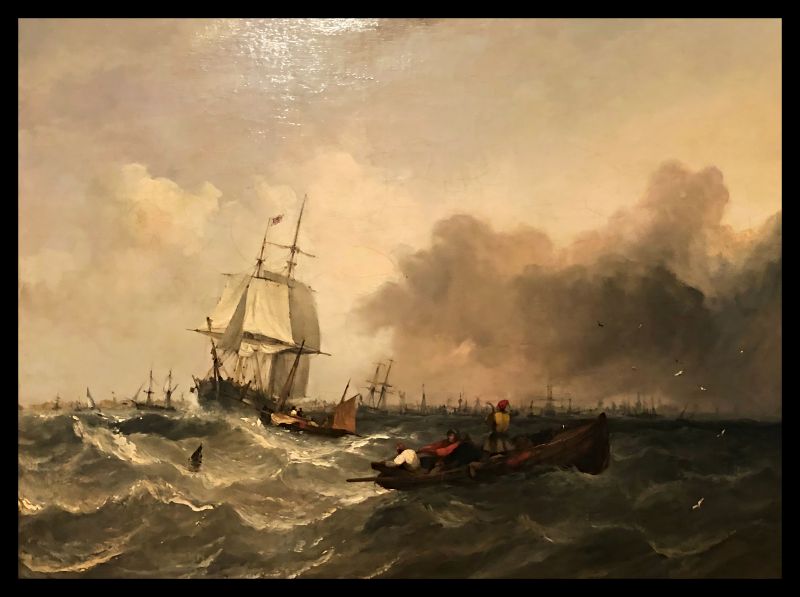 ‘A collier brig and other shipping in a choppy sea off Whitby’ by the Whitby-born artist George Chambers (1803-1840). Chambers was an established marine painter in the early 1830s, from which years this oil on canvas most probably can be dated. Notice the yellow, red and white jackets – easily obtainable colours for most individuals – worn by the three men in the small boat. These shades from natural dyes or un-dyed wools illustrated on garments in marine art are also evident from a broader British and West European perspective, judging by a close-up study of a large number of paintings dating from the 17th to the early 19th centuries. On display in the extensive exhibition at the Maritime Museum in Hamburg, as well as at Whitby Museum and Pannett Park Art Gallery in Whitby. (Collection: Internationales Maritimes Museum Hamburg, Germany. Artwork in Exhibition). Photo: Viveka Hansen, The IK Foundation.
‘A collier brig and other shipping in a choppy sea off Whitby’ by the Whitby-born artist George Chambers (1803-1840). Chambers was an established marine painter in the early 1830s, from which years this oil on canvas most probably can be dated. Notice the yellow, red and white jackets – easily obtainable colours for most individuals – worn by the three men in the small boat. These shades from natural dyes or un-dyed wools illustrated on garments in marine art are also evident from a broader British and West European perspective, judging by a close-up study of a large number of paintings dating from the 17th to the early 19th centuries. On display in the extensive exhibition at the Maritime Museum in Hamburg, as well as at Whitby Museum and Pannett Park Art Gallery in Whitby. (Collection: Internationales Maritimes Museum Hamburg, Germany. Artwork in Exhibition). Photo: Viveka Hansen, The IK Foundation.Another enlightening source is the publication Costume of Yorkshire by George Walker, published in 1814, which contains forty engravings, including fishermen ‘on the beach near Filey’. The three fishermen, accompanied by two young women, are wearing jackets seemingly made from substantial warm woollen fabric and what looks like long grey or white knitted stockings covering their legs up to well above the knees, evidence that some knitted clothes were already being worn by Yorkshire fishermen in the early 19th century. Another valuable source of information from the Whitby area of the 1830s and 1840s, Dr English Prints, also includes fishermen from that period. A clear example is ‘Whitby from the Sands’ by Edwin Cockburn, dated 1843 or 1848, depicting fishermen wearing not knitted sweaters but rather some type of jacket. The same applies to several other prints of Robin Hood's Bay from the same period. Whilst ‘Whitby from the West Pier’, initially published in 1836, Henry Belcher’s The Scenery of the Line of the Whitby and Pickering Railway shows two fishermen on the pier in the traditional clothing of their time, as illustrated below.
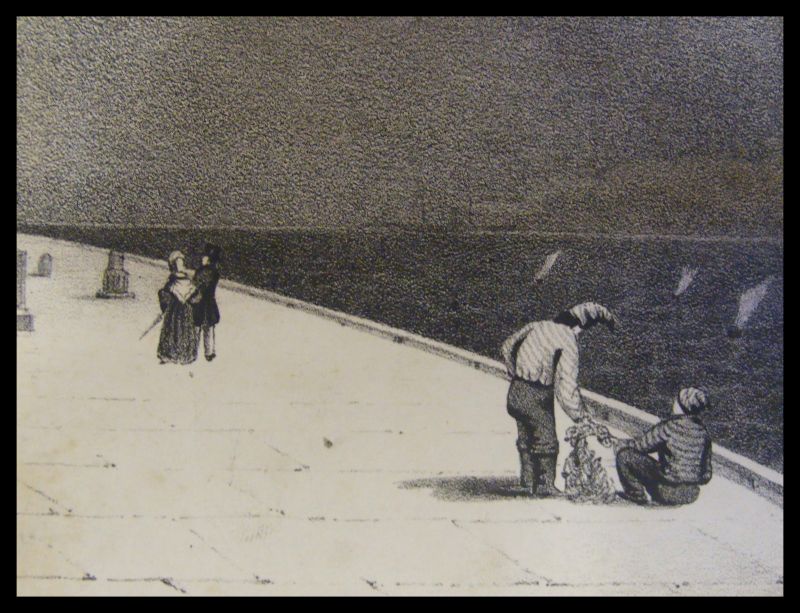 ‘West Pier & Lighthouse at Whitby 1840’ (originally from 1836), a print which visualised two fishermen in knitted striped woollen sweaters and caps. (Courtesy: Whitby Museum, Library & Archive, Plans and Views of Whitby, 769.942.74. part of the image).
‘West Pier & Lighthouse at Whitby 1840’ (originally from 1836), a print which visualised two fishermen in knitted striped woollen sweaters and caps. (Courtesy: Whitby Museum, Library & Archive, Plans and Views of Whitby, 769.942.74. part of the image).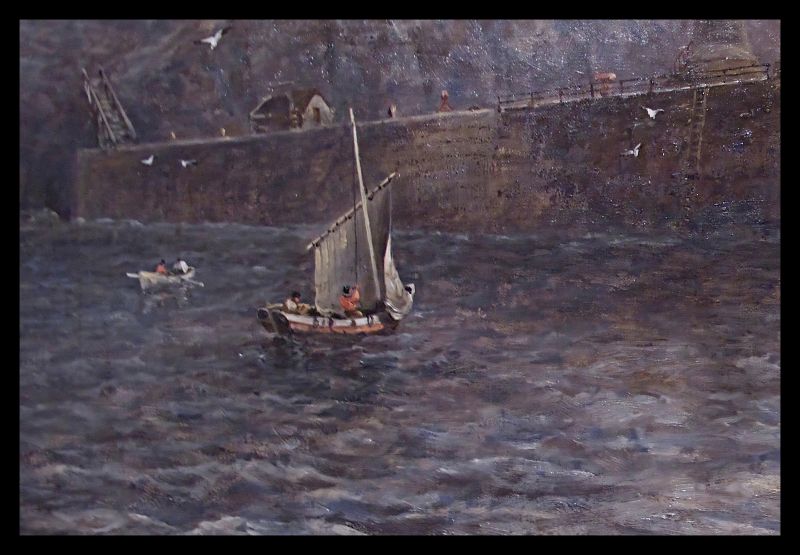 ‘The Haven under the Hill’, oil on canvas by Richard Weatherill, late 1860s. Still, around this year, it is visible that fishermen in small boats around Whitby harbour were dressed in red coloured upper garments. (Collection: Pannett Park Art Gallery, Whitby, United Kingdom. Part of painting). Photo: Viveka Hansen, The IK Foundation.
‘The Haven under the Hill’, oil on canvas by Richard Weatherill, late 1860s. Still, around this year, it is visible that fishermen in small boats around Whitby harbour were dressed in red coloured upper garments. (Collection: Pannett Park Art Gallery, Whitby, United Kingdom. Part of painting). Photo: Viveka Hansen, The IK Foundation.As briefly mentioned in the introduction, before the 1860s, dark blue was an expensive colour requiring much sought-after indigo or woad, which in effect restricted it to the more well-off. In watercolours and oil paintings of the Whitby harbour area by the local artists George Weatherill (1810-1890) and his son Richard Weatherill (1844-1913), clear examples of fishermen’s sweaters and jackets both before and after the dark blue ganseys became popular have been detected. Not all their paintings are dated, but some can be placed before this period, judging by the colour of these outer garments, yellowish or red sweaters or jackets being seen on the men portrayed in their small fishing boats like in the painting above by the son, while one of his watercolours dated 1879 includes fishermen dressed in dark-blue ganseys as well as garments with other colours.
There is no historical proof of any early large-scale hand or frame knitting in Whitby, though there was a significant tradition of stocking-knitting elsewhere in Yorkshire in Wensleydale and Swaledale, which lasted several hundred years before falling away early in the 19th century. Whitby was like other fishing communities in that the art of knitting flourished there during the second half of the century with warm, water-resistant sweaters, usually knitted in dark blue wool. These were known as ganseys or guernseys. Precisely when they began to be knitted for fishermen is disputed, but it was probably gradually during the 1860s to the 1870s. However, there are signs via various artworks that striped pull-overs at least were in use several decades earlier. Accurate dating is particularly difficult as there are no written sources of patterns, models and traditions since those who knitted ganseys at this time, whether female or male, were seldom literate. Skills were passed down orally from one generation to the next, and each particular family would keep its style of patterns within the family circle. It was principally the women, helped by their older daughters, who did the knitting during free moments amid their many other duties. Fishermen’s wives led strenuous lives, helping in many areas of the fishing business while being responsible for washing, cleaning and food preparation within the home. Besides, fishing folk often had large families, with many of the women probably dying prematurely because of very long working days, the constant cold involved in fishing work, miscarriages caused by lifting heavy weights or, quite simply, too frequent pregnancies. At the same time, knitting must have come as a welcome break in the working day, giving the women an opportunity to create individual design patterns for the ganseys they were knitting for their husbands and sons. But it also seems not to have been unusual for the men themselves to be able to knit, particularly those condemned to long fishing expeditions by sea when knitting could be a convenient way of making use of free moments.
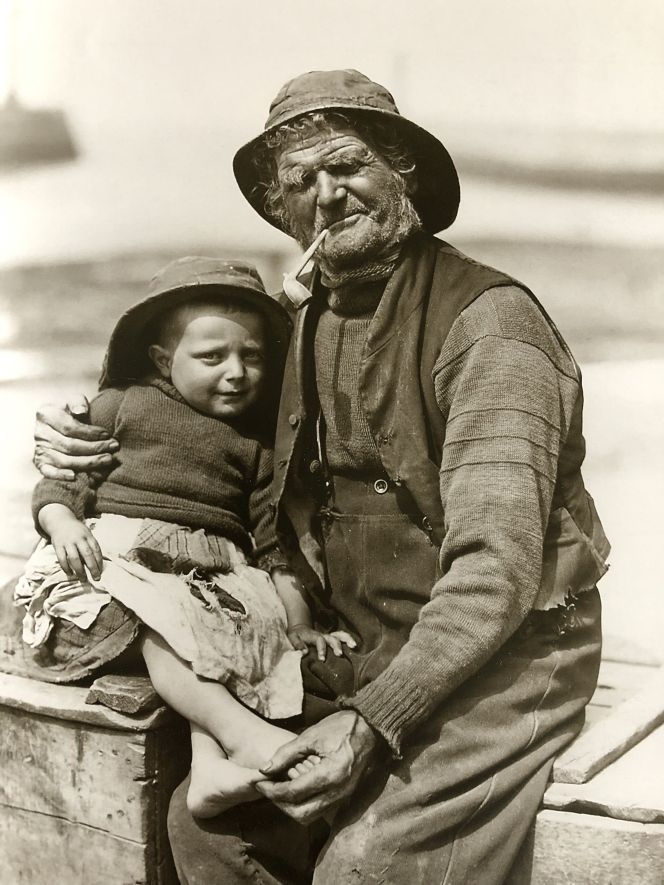 The fisherman John Robert Storr and his grandson wore knitted woollen gansey in 1884. Thanks to the tireless work of Frank Meadow Sutcliffe (1853-1941), who photographed the fishing population of Whitby during the period from about 1880 to 1910, there is today an extensive collection of depictions of knitted ganseys. (Courtesy: Whitby Museum, Photographic Collection, Sutcliffe E.17. Whitby Lit. & Phil.).
The fisherman John Robert Storr and his grandson wore knitted woollen gansey in 1884. Thanks to the tireless work of Frank Meadow Sutcliffe (1853-1941), who photographed the fishing population of Whitby during the period from about 1880 to 1910, there is today an extensive collection of depictions of knitted ganseys. (Courtesy: Whitby Museum, Photographic Collection, Sutcliffe E.17. Whitby Lit. & Phil.).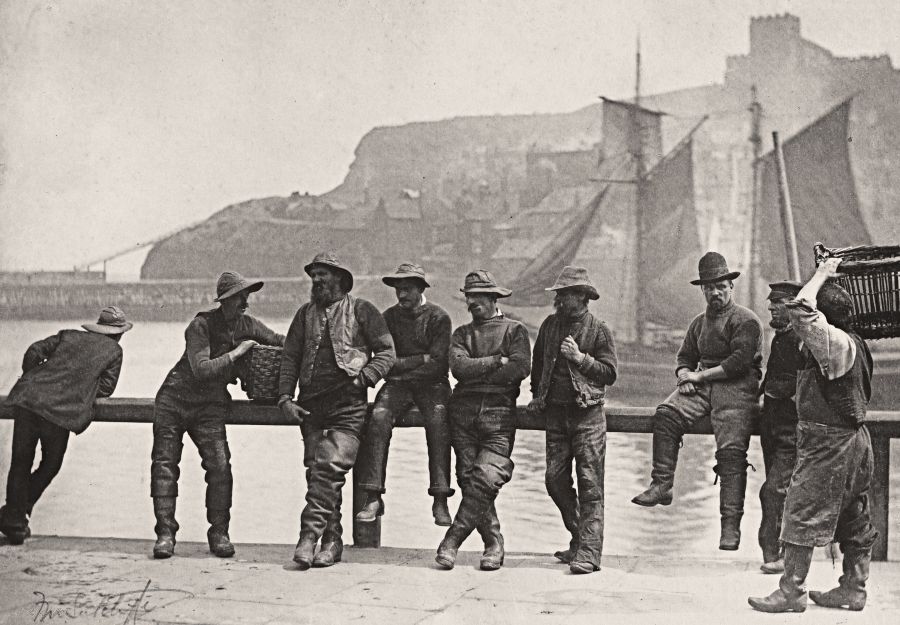 Whitby fishermen in Whitby harbour, circa 1885, most wearing blue knitted ganseys. (Courtesy: National Gallery of Art, Washington. Public Domain). Photo: Frank Meadow Sutcliffe.
Whitby fishermen in Whitby harbour, circa 1885, most wearing blue knitted ganseys. (Courtesy: National Gallery of Art, Washington. Public Domain). Photo: Frank Meadow Sutcliffe. This photograph by Frank Meadow Sutcliffe is clear evidence once more that in Whitby, the knitted woollen ganseys were worn both by adult fishermen and their sons. (Courtesy: Whitby Museum, Photographic Collection, Sutcliffe 24-33E. Whitby Lit. & Phil.)
This photograph by Frank Meadow Sutcliffe is clear evidence once more that in Whitby, the knitted woollen ganseys were worn both by adult fishermen and their sons. (Courtesy: Whitby Museum, Photographic Collection, Sutcliffe 24-33E. Whitby Lit. & Phil.) 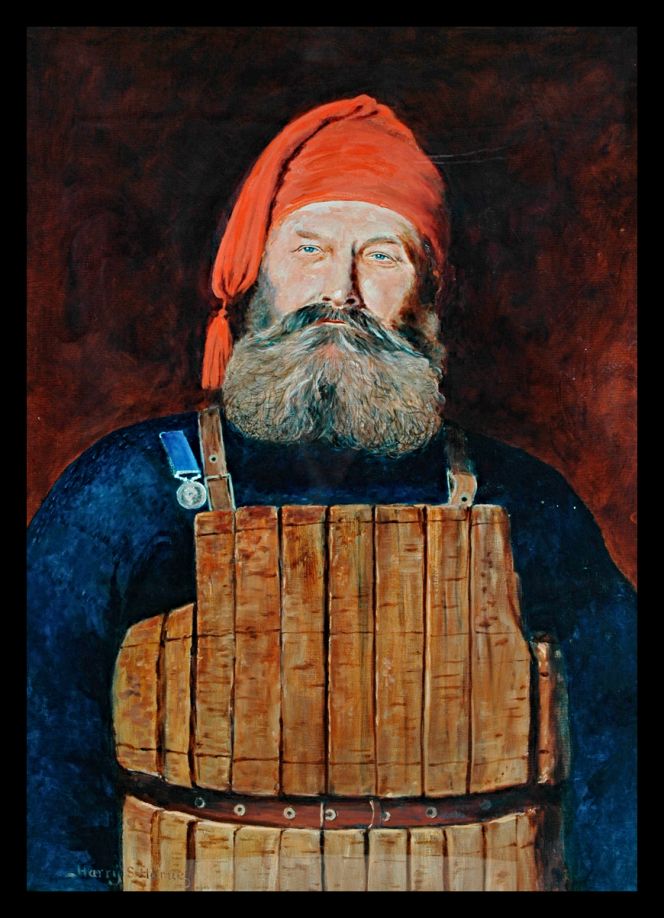 A final illustrative example is this portrait by Harry S. Horne, painted in oils on canvas in 1903, which shows Henry Freeman, the ‘Sole Survivor of the Whitby Lifeboat Disaster 1861’ when twelve members of a lifeboat crew drowned near the pier. Maybe he was depicted wearing the type of clothes in which he was rescued, but there is some uncertainty about this conclusion, as it seems like most fishermen still wore various cloth jackets and stripy knitted sweaters as an upper garment during the 1860s. However, Freeman is here more than 40 years later, dressed in the by-then traditional blue knitted gansey under a cork life jacket and wearing a knitted red woollen cap with a tassel on his head. Interestingly, he was photographed wearing the same clothes in a similar pose several times. (Courtesy: Whitby Museum, PEF32. (Whitby Lit. & Phil.).
A final illustrative example is this portrait by Harry S. Horne, painted in oils on canvas in 1903, which shows Henry Freeman, the ‘Sole Survivor of the Whitby Lifeboat Disaster 1861’ when twelve members of a lifeboat crew drowned near the pier. Maybe he was depicted wearing the type of clothes in which he was rescued, but there is some uncertainty about this conclusion, as it seems like most fishermen still wore various cloth jackets and stripy knitted sweaters as an upper garment during the 1860s. However, Freeman is here more than 40 years later, dressed in the by-then traditional blue knitted gansey under a cork life jacket and wearing a knitted red woollen cap with a tassel on his head. Interestingly, he was photographed wearing the same clothes in a similar pose several times. (Courtesy: Whitby Museum, PEF32. (Whitby Lit. & Phil.).Ganseys of this type were always made in a single colour, usually dark blue, in a 4 or 5-ply worsted wool. Other colours might also be used, but never green, as that was thought to bring the bearer bad luck. The knitting of patterns was usually restricted to the upper part of the garment for reasons of warmth and appearance. Seven or eight design variations can definitely be traced to Whitby. Still, there was also an influence from Scottish designs since fishermen from Scotland would visit Whitby during the herring-fishing season in August and September. Many of these woollen sweaters have simple combinations of plain and purl stitched stripes added with moss patterns, while cables are also common in various forms. Everyday life in a local community seen from the perspective of fishermen’s upper garments during the 19th century – has, in other words, been possible to trace via print culture, the historical circumstances for natural and synthetic dyes, artworks, photographs and not least via the craft skills needed to knit these warm and practical woollen sweaters.
Sources:
- Belcher, Henry, The Scenery of the Line of the Whitby and Pickering Railway, London 1836.
- Frank, Peter, Yorkshire Fisherfolk, UK 2002.
- Hansen, Viveka, The Textile History of Whitby 1700-1914 – A lively coastal town between the North Sea and North York Moors’, London & Whitby 2015 (pp. 273-285).
- Internationales Maritimes Museum Hamburg, Germany. (Visit to the Maritime Art Exhibition in January 2020).
- Pannett Park Art Gallery, Whitby, United Kingdom (visits from 2006-2010).
- Rutt, Richard, A History of Hand Knitting, UK 1998.
- The Public Catalogue Foundation, Oil Paintings in Public Ownership in North Yorkshire, London 2006.
- Thomson, Gladys, Patterns for Guernseys, Jerseys & Arans, UK 1979.
- Walker, George, The Costume of Yorkshire, London 1814.
- Whitby Museum (Whitby Lit. & Phil.), Whitby, United Kingdom. | Costume Collection (local ganseys, early 20th century). | Library & Archive (‘Dr English Prints – a fine collection of prints of Whitby from early 19th century’ & Plans and Views of Whitby). | Photographic Collection (Sutcliffe collection & other local photographs). | Research made during the years 2007-2012.
More in Books & Art:
Essays
The iTEXTILIS is a division of The IK Workshop Society – a global and unique forum for all those interested in Natural & Cultural History from a textile Perspective.
Open Access essays, licensed under Creative Commons and freely accessible, by Textile historian Viveka Hansen, aim to integrate her current research, printed monographs, and earlier projects dating back to the late 1980s. Some essays feature rare archive material originally published in other languages, now available in English for the first time, revealing aspects of history that were previously little known outside northern European countries. Her work also explores various topics, including the textile trade, material culture, cloth manufacturing, fashion, natural dyeing, and the intriguing world of early travelling naturalists – such as the "Linnaean network" – viewed through a global historical lens.
For regular updates and to fully utilise iTEXTILIS' features, we recommend subscribing to our newsletter, iMESSENGER.
been copied to your clipboard




– a truly European organisation since 1988
Legal issues | Forget me | and much more...
You are welcome to use the information and knowledge from
The IK Workshop Society, as long as you follow a few simple rules.
LEARN MORE & I AGREE







